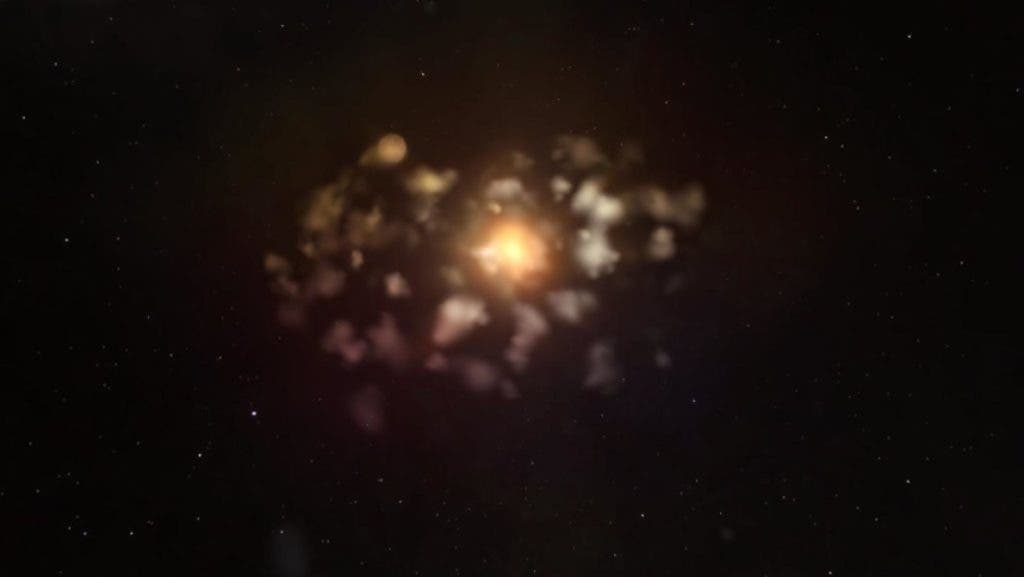Some 550 light years away from Earth, a star in the Pisces constellation is busy consuming one or more of its orbiting planets. The find offers a glimpse into our own solar system’s tumultuous past.

Image credits NASA Goddard Space Flight Center.
The star RZ Piscium has been caught red-handed while grinding one (or several) of its orbiting planets into dust and gas, according to a new paper published by Indiana University researchers. This “eater of worlds” could help us better understand early star systems, including our own, which tend to be very dynamic and unstable.
Wilder, younger days
Our solar system might be a neat and tidy place today, but this wasn’t always the case. Even planetary systems which are relatively uneventful now start out as very unstable constructs. Newly born planets interact strongly with one another and with their host star, catching and being caught in gravitational fields, wreaking havoc on their trajectories through space. For example, it’s speculated that 4 billion years or so ago, Uranus and Neptune swapped their orbits. Now, they’re stable.
More mature systems tend to simmer down as the planets to settle into more stable and regular orbits, just like Uranus and Neptune did. However, RZ Piscicum is nowhere near there.
“We know it’s not uncommon for planets to migrate inward in young solar systems since we’ve found so many solar systems with ‘hot Jupiters‘ — gaseous planets similar in size to Jupiter but orbiting very close to their stars,” said co-author Catherine Pilachowski.
“This is a very interesting phase in the evolution of planetary systems, and we’re lucky to catch a solar system in the middle of the process since it happens so quickly compared to the lifetimes of stars.”
Planets that come too close to their stars crack and strain under their immense gravitational forces, and are officially dubbed “disrupted planets”. In the case of RZ Piscium, all the material ripped from the planet/planets is being slowly spread around into a small circle of debris. It orbits approximately as far from the star as Mercury orbits relative to our sun.
This proximity is causing some problems for the researchers, as it doesn’t allow them to get a good look at anything near the star. However, based on current observations, they report that we’re either “seeing a fairly massive, gaseous planet” breaking down near the star, or “perhaps two gas-rich planets that have collided and been torn apart.”
Light reading
With a background in light spectrometry analysis, it fell to Pilachowski to determine the strength of RZ Piscium’s gravitational pull. Using this information, the team then calculated its radius and brightness — both of which point to a young star still grappling with unruly planets. Pilachowski’s work also helped the team determine the amount of lithium in the star. This element is used as an indicator of stellar age, as it tends to be consumed at a steady rate in stars that reach a high enough temperature. Lithium levels indicate that RZ Piscium is between 30 and 50 million years old.
Determining the age of RZ Piscium was fundamental to the study. The debris field observed around the star could have also been formed by the destruction of planets near an old, growing star, as it’s headed for collapse.
The team also report that the star’s temperature is about 5,330 degrees Celsius (9,600 Fahrenheit), which is only somewhat cooler than our own sun.
“This discovery really gives us a rare and beautiful glimpse into what happens to many newly formed planets that don’t survive the early dynamical chaos of young solar systems,” Pilachowski said.
“It helps us understand why some young solar systems survive — and some don’t.”
The researchers were drawn to this system because of the star’s “extreme optical dropout events and strikingly large excess infrared emission” — which would suggest there’s something coming between us and the star at times, and it’s likely a cloud that catches its energy and releases it as heat. The data was recorded using ESA’s X-ray Multi-Mirror Mission (XMM-Newton), the Hamilton Echelle 3m spectrometer at the Lick Shane observatory, and the High Resolution Echelle Spectrometer (HIRES) from the W.M. Keck Observatory in Hawaii.
The paper “Is the Young Star RZ Piscium Consuming Its Own (Planetary) Offspring?” has been published in The Astronomical Journal.






